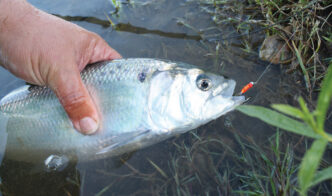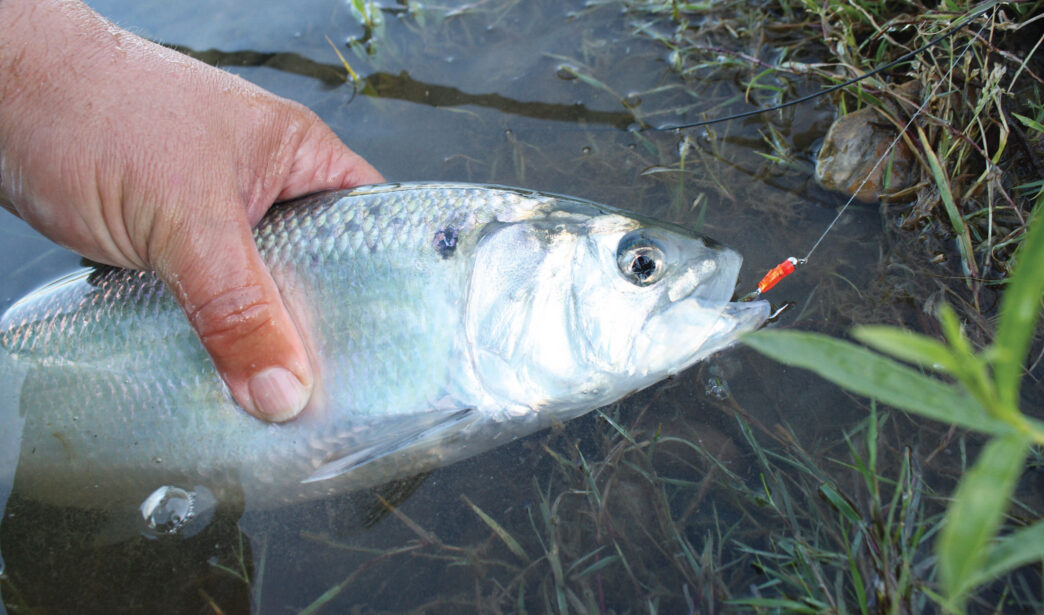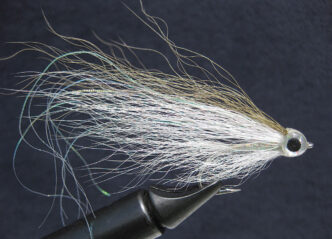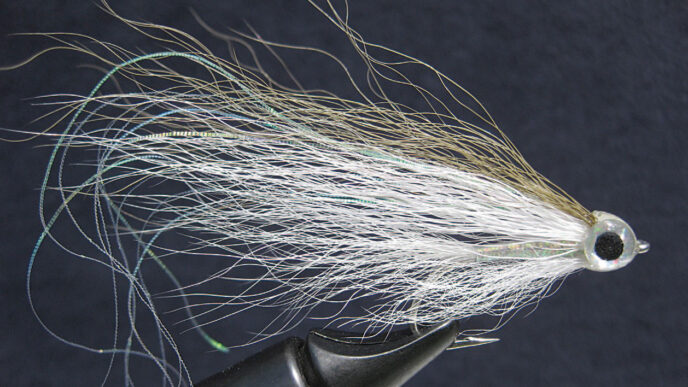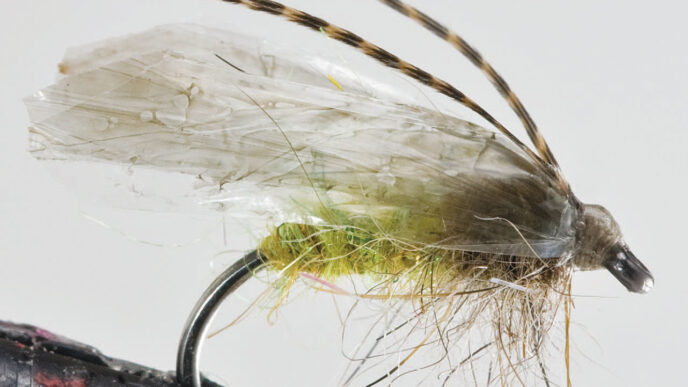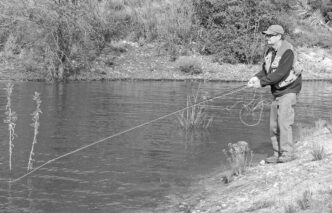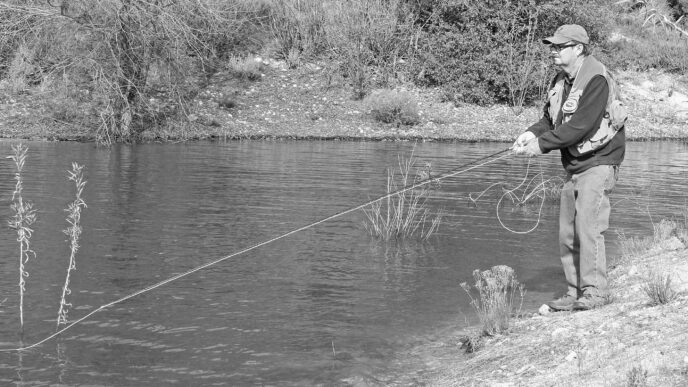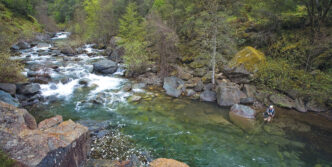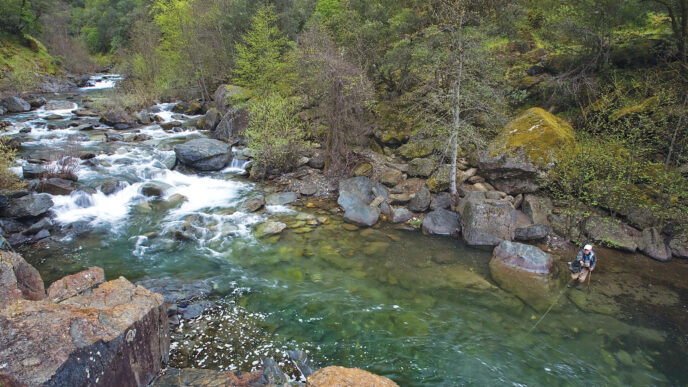On a balmy spring day in early May, I was driving my old truck along Highway 45, which meanders beside the Sacramento River. I was headed to Chico to pick up some fly-tying materials from my brother’s fly shop, daydreaming, just minding my own business, “driving like an old man,” as my wife says. I caught myself humming, sometimes singing to the country melody crackling from the radio. Then, all of a sudden, I caught glimpse of something that made my heart race, my thoughts scramble, and my hands tremble. What I saw was cotton floating from the trees. And all I could think about was shad — the poor man’s tarpon, the boney ’bow, or whatever you call them. It was shad time!
Shad astonish me every year. After all the anticipation, there is something about realizing that the moment is here. It’s a time of the year that reminds me of my youth, friends, and fishing pals not with us any longer. It’s a special time for reflection and remembering. It’s also about the pure delight of the grab. My thoughts shifted suddenly to integrated shooting heads, heavy 3X tippets, and shad flies. (Do I have enough?) My mind became a blur with preparation.
American Shad
The American Shad (Alosa sapidissima) is not native to the West Coast. On June 19, 1871, the famed fish culturist Seth Green left New York en route to California with milk canisters filled with 12,000 shad fry. These makeshift fish incubators holding the Hudson River strain of shad traveled by train through hot, terrible weather. At times, Green had to aerate the water by hand, pouring pails of water into other buckets. The 10,000 shad fry that survived the trip were turned loose from their tin prisons at the Sacramento River’s edge in the small city of Tehama. A couple of years later, in 1873, California Fish Commissioner B. B. Redding offered a reward of $50 for the first adult shad to be caught from the Sacramento River. The reward was paid.
The fish have adapted to the West Coast, flourishing up and down the Pacific shore. Two of the largest runs are seen in the Sacramento and Columbia River systems, with fish ranging clear up into the lower Snake River.
Aside from the Sacramento, in California, shad runs are found in the lower Klamath, Trinity, San Joaquin, American, Feather, Yuba, and Russian Rivers. Fish start to enter the rivers in late April, and the runs peak in June and July, during the spawning period.
The way shad spawn is a little different from the way other anadromous species do it. Shad don’t make nests in the gravel. Female shad instead release their eggs in the water column, and as the eggs drift the males fertilize them, a process called “broadcast spawning.”The eggs then fall to the gravel bottom to hatch. The fry stay in the river and grow until they migrate to the sea in the fall. The young shad range in size from an inch and a half to four inches in length.
The Grab
Last year, I was fortunate to pass along the experience of a kid’s first shad grab to my 10-year-old son, Garrett. We went out to the Sacramento River and fished a spot that I have fished for years. The run holds a special place in my heart — not for being a place where I passed my youth wetting lines and drinking beers with friends, but for being the place where I landed my first shad, when I was growing up.
It was a hot evening. The sun was still high in the sky as we reached the run. Garrett and I put on waders and set up our rods. I handed him a switch rod that was ready for his first cast — he is a good caster. After I placed him in the perfect spot, his first cast with the integrated shooting head was a little sloppy, but it reached roughly 50 feet. I explained to him that the fish usually grab the fly during the swing, and I whispered in his ear, “Be prepared.”
The action was slow, and I was getting a little restless. Garrett was being a trooper, casting really well, each cast no more than 50 feet or so. Then, out of the blue, I heard a loud “WOW!!” I looked upstream, and his rod was doubled over.
I started to coach him — “Reel in, lift your rod, move your rod tip down and to the right!” I think I was more excited than he was.
He would just say, “I got this, Dad.”
He did. Garrett landed a beautiful shad. He just looked at me, smiled, and gave me knuckles. It was a magical moment in our relationship. Moments like that are absolutely perfect.
Garrett complained that I was taking too many pictures of him. He was getting a little agitated with me. He looked at me and said, “Dad, we need to fish. I need to get another grab!”
The Rivers
With fish numbering in the hundreds of thousands, the Sacramento River holds the largest run of shad in California’s rivers, with the American being second, followed by the Feather and Yuba. That makes the Sacramento River and its tributaries the place to fish for these split-tail motorboats.
Unfortunately, the Sacramento River has limited access for wading anglers. In the old days (20 years ago) there was plenty of public access, but with vandalism and theft occurring on farmers’ lands, gates and no-trespassing signs have gone up. There is still access — especially by boat. However, wading anglers have to rely on a few popular places where the public can reach the river: Verona Bar, the Colusa channels, and areas such as the Washout in Chico, or up at Woodson Bridge, just east of Corning. Anglers who have boats can explore the entire river, anchoring or beaching the boat and finding runs that are easily fished.
The American River offers the best and greatest number of access areas for wading anglers, with a wide variety of runs and riffles to fish. The upper river has many access points, from Watt Avenue all the way up to Sailors Bar, and these areas are easy to wade and fish. Long runs can be found, and with a little exploration, you can avoid the worst crowds — some areas, such as upper Sunrise, are extremely popular, with anglers staking claims to their spots. Boat access is also good on the American, with many anglers running drift or pontoon boats. Using boats to find areas to fish is the best way of breaking away from the crowds. Many anglers use switch and short Spey rods as their weapons of choice there.
The Yuba and the Feather Rivers have limited access for wading anglers. Again, a boat is a great advantage. On the Feather River, the Palm Riffle and Lower Kester Riffles hold shad and can be accessed by wading anglers. Motorized boats are used to navigate the lower river from Gridley to Verona — the confluence of the Feather with the Sacramento. The Yuba has even fewer access points for wading anglers. Many anglers use jet, drift, or pontoon boats to navigate the water to find good shad runs.
Fishing for Shad
Shad hold in runs where the current is at “walking speed” — not too fast or too slow. That flow, in water 6 to 12 feet deep, is ideal. In essence, you’re seeking water where the fish can rest. Such places include in front of riffles, in a middle of a run where they have the depth and current speed to spawn, in areas that are channelized, and where there is a dramatic change in water depth — from a hole that is 20 feet deep to a riffle that is 3 feet deep, for example. These last areas are good places to target when the shad are traveling. Shad hold in the deeper water and shoot into the shallow riffle, usually not stopping until they reach deeper, safer water, where they can again rest.
Shad need to feel comfortable in the areas where they hold. They are always wary of birds and other predators, including striped bass. The fish move up and down in the water column in the holding areas. In currents 6 to 12 feet deep with walking speed, in periods of full sunlight, fish are usually found three-quarters of the way down the water column — that is, fairly close to the bottom. As the sun goes down and there is less sunlight on the water, the fish rise in the water column and start to go into active spawning mode.
Shad school up, so when you find a fish, it’s a good indication that you’ve found water that holds others. Such areas will consistently hold shad throughout the season, as long as water flows don’t change. If the flows rise or drop, the angler must adjust by searching for the fish again. Once the shad start to spawn, the numbers of traveling fish drop dramatically, and anglers must fish areas that consistently share the ideal flow and depth characteristics.
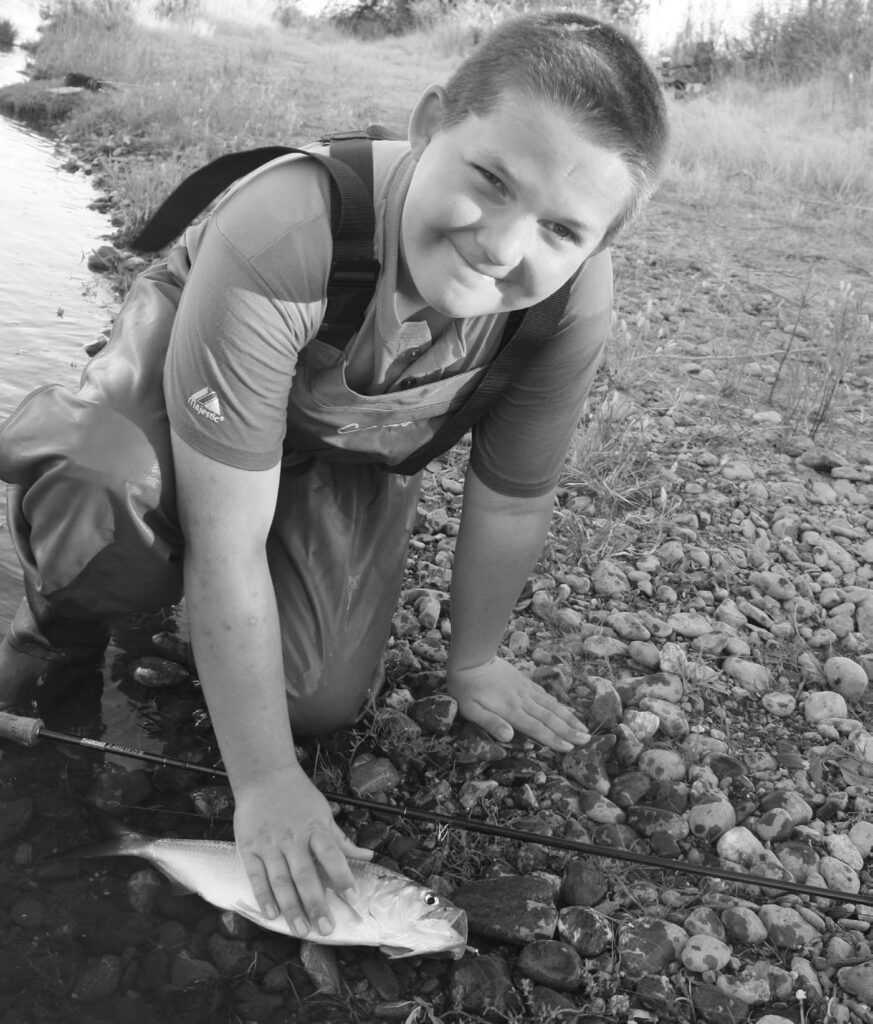
Basic Tactics and Equipment
Swinging flies is the easiest and oldest style of fly fishing, and shad love a swinging fly. Using a sinking line, the angler casts across the current and lets the fly swing on a tight line. The cast should end straight below you, downriver. Many anglers twitch the line as it swings across, while others hold steady on the swing and add twitches as the fly hangs straight downstream. Still others throw a mend into the line and have the fly zip across the water column at the end of the swing.
Single-handed and two-handed rods in the range of 6-weight to 8-weight can be used for this style of fishing. A singlehanded fast-action rod with a fighting butt is ideal. A switch rod or a short Spey rod is a perfect choice among two-handed rods. Your rod must have the power to lift sinking lines from the water and to cast them into the wind. And you need a well-made reel with a smooth drag to protect tippets from the shads’ lightening runs and bursts of energy.
The biggest and most important part of hooking shad is getting the fly at the right spot in the water column, and that starts with fishing a sinking line with the right sink rate. Using shooting heads or sink-tip lines with different sink rates is mandatory with both single-handed and two-handed rods. In walking-speed water 6 to 12 feet deep, a Type 4 sinking line (4 inches per second) is ideal. If you don’t find fish after multiple casts, you can change to a Type 6 and fish deeper, or you can go lighter to a Type 3 and fish shallower until you hit fish.
For single-handed rods, floating lines tipped with sinking leaders also can work, in effect creating a kind of shooting-head system. Using either shooting heads or
sinking leaders will give anglers the advantage of changing their rigs to match the depth of the water. Lines that have the shooting head integrated with the running line, however, are easier to cast than shooting heads attached to a monofilament running line. Two-handed casters can also use Skagit or Scandi shooting heads. Skagits and Scandies should be matched with proper sink-rate leaders or MOW tips.
Leaders are as simple as they come. I like a 4-foot, two-part tapered leader, with tippets ranging from 8 to 10 pounds test. They’re easy to build: 2 feet of 15-pound test and 2 feet of 10-pound, or 2 feet of 12-pound test and 2 feet of 8-pound — your choice. Marry the two pieces with a Blood Knot. Another leader system is to use the middle portion of your worn trout leaders. Merely cut the butt section off, and you have a leader to use for shad.
Shad are mostly plankton eaters, so it is not clear why they take a fly. There are many different local patterns for shad flies out there, and many anglers have a “secret” shad fly. Whatever the pattern, the fly should be tied on a high-quality debarbed hook. Having hooks bend or break is not good, and shad stress every piece of your equipment. Some great flies for shad are the Green Death, Simmons’s Shad Fly, Gray’s Ice Candy, the Shad Dart, and the Bloody Maria. Top colors for flies are chartreuse and orange.
If You Go . . .
For general information and specifics about regulations and licenses, consult the California Department of Fish and Wildlife website at http://www.dfg.ca.gov.
Information about water flows throughout the state can be found at http://cdec.water.ca.gov/river/rivcond.html. River flows also can be found at the following websites.
For flows in the Sacramento River at Verona:
http://waterdata.usgs.gov/ca/nwis/uv/?site_no=11425500&PARAmeter_cd=00065,00060.
For flows in the Sacramento River at Colusa:
http://waterdata.usgs.gov/ca/nwis/uv/?site_no=11389500&PARAmeter_cd=00065,00060.
For flows in the American River:
http://waterdata.usgs.gov/ca/nwis/uv/?site_no=11446500&PARAmeter_cd=00065,00060.
When using these links to check river flows, anglers must keep in mind that high flows can be dangerous to wade. Always check the flows before you fish to determine what parts of the river are likely to be safe to fish. For example, the lower American River tends to be wadeable all the way up to 5,000 cubic feet per second. Certain areas, such as Sunrise and Gristmill, can be safe to wade at even higher flow rates. The Sacramento is safe to wade at 8,000 cfs at the Washout in Chico, but for anything above that it gets to be a little hairy. As for the Yuba, 2,500 cfs is tops for wading. On the Feather River, wading in the high-flow section is generally done in all flows, but 4,000 cfs is perfect. Always be cautious, though.
Whether wading or boating, make sure you have safety gear with you. A PFD (personal floatation device), wading staff, good boots, and sunglasses that allow you to see the bottom while wading are all must-have equipment.
Fly shops near shad rivers include, in Sacramento, Kiene’s Fly Shop, (800) 4000359, http://www.kiene.com, and the American Fly Fishing Company, (800) 4101222, http://www.americanflyfishing.com; in Citrus Heights, Fly Fishing Specialties, (916) 722-1055, http://www.flyfishingspecialties.com; in Chico, the Sierra Stream Fly Shop, (530) 345-6241, http://tie-fast.com, Fish First!, (530) 343-8300, http://www.fishfirst.com, and the Chico Fly Shop, (530) 345-9983, http://thechicoflyshop.com; in Redding, The Fly Shop, (800) 669-3474, shop.com; and, in Lewiston, the Trinity Fly Shop, (530) 623-6757, http://www.trinityflyshop.com. Each of these shops should be able to connect you with a guide.
You can also use the Internet to find a guide. Among those who who offer shad trips are Bill Lowe, http://www.billloweflyguide.com; Al Smatsky, http://www.excellentadventures.org; Andy Guibord, struction; Hogan Brown, http://hgbflyfishing.com; Ryan Johnston, trips.com; and Lance Gray and Company, http://lancegrayandcompany.com.
You can consult the following for maps and access points. For the Sacramento River, http://www.sacramentoriver.org/sac_river_atlas.php. For the American River, http://www.fishsniffer.com/maps/americanriver.html.
Bulletin boards are a great way of getting information. Check out, for example, the boards at Kiene’s Fly Shop, http://www.kiene.com/forums/forum.php; and Dan Blanton’s Fly Fishing Forum and Bulletin Board at http://www.danblanton.com/bulletin.php.
Lance Gray



